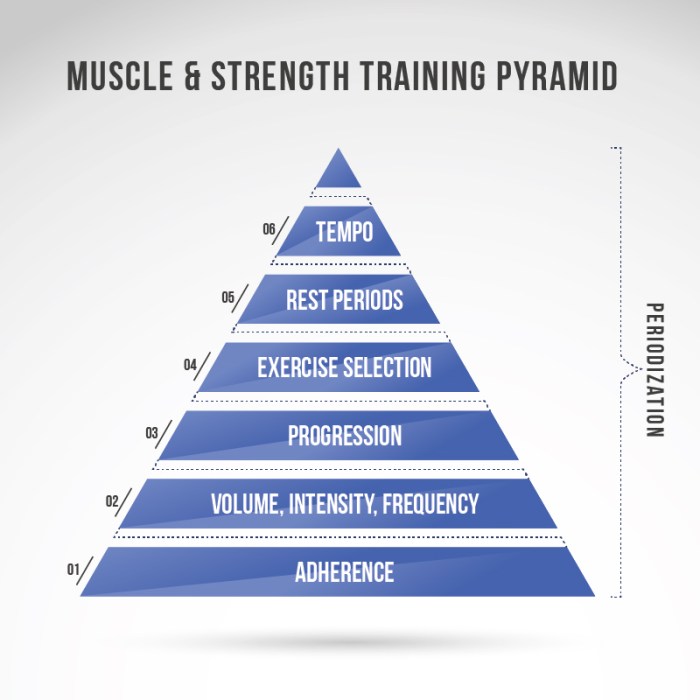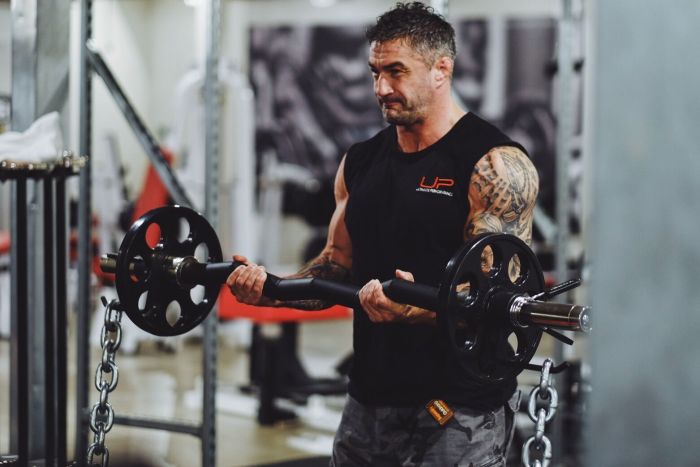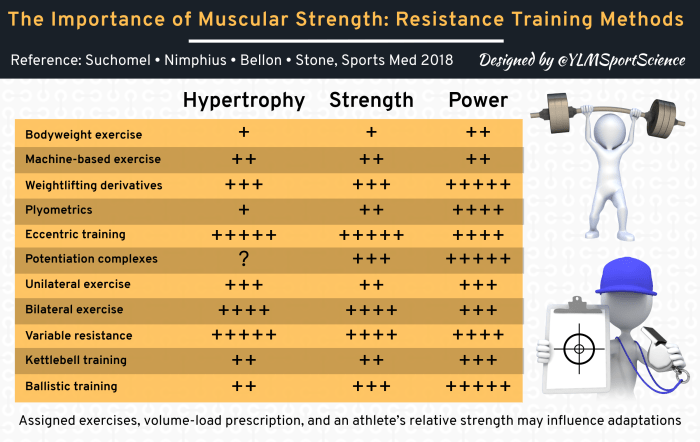Muscular strength training methods – Embark on a transformative journey to enhance your muscular strength with this comprehensive guide to proven training methods. From progressive overload to periodization, discover the secrets to building a stronger, more resilient physique.
As we delve into the realm of muscular strength training methods, we’ll explore the science behind effective exercise selection, optimal sets, reps, and rest periods, and the importance of recovery and nutrition. Whether you’re a seasoned athlete or just starting your fitness journey, this guide will empower you with the knowledge and strategies to achieve your strength-building goals.
Introduction to Muscular Strength Training Methods

Muscular strength training, often referred to as weightlifting or resistance training, is a crucial component of overall fitness. It involves exercises that challenge your muscles against an external resistance, such as weights, machines, or even your own body weight.
Regular muscular strength training offers numerous benefits, including increased muscle mass, improved bone density, enhanced balance and coordination, reduced risk of chronic diseases, and overall better quality of life. By incorporating muscular strength training into your fitness routine, you can not only improve your physical abilities but also promote long-term health and well-being.
Types of Muscular Strength Training Methods
There are various types of muscular strength training methods, each with its unique characteristics and benefits. Some of the most common methods include:
- Barbell training:This method involves using barbells, which are long, weighted bars, to perform exercises such as squats, bench press, and deadlifts.
- Dumbbell training:Similar to barbell training, dumbbell training utilizes dumbbells, which are individual weights with handles, for exercises like bicep curls, shoulder press, and lunges.
- Machine training:Machine training involves using weightlifting machines that provide a guided range of motion, making them suitable for beginners or individuals with specific rehabilitation needs.
- Bodyweight training:This method utilizes your own body weight as resistance for exercises like push-ups, pull-ups, and squats.
- Resistance band training:Resistance bands are elastic bands that provide variable resistance, making them versatile for a wide range of exercises.
The choice of muscular strength training method depends on your fitness level, goals, and personal preferences. It’s recommended to consult with a qualified fitness professional to determine the most appropriate method for you.
Progressive Overload

Progressive overload is a training principle that involves gradually increasing the demands placed on your muscles over time. This can be done by increasing the weight you lift, the number of repetitions you perform, or the number of sets you complete.Progressive overload is an important principle in fitness because it allows your muscles to adapt and grow stronger.
When you first start training, your muscles are not used to the demands of exercise. As you continue to train, your muscles will adapt and become stronger. However, if you do not continue to challenge your muscles, they will eventually stop growing.There are many different methods of progressive overload.
Some of the most common methods include:
- Increasing the weight you lift
- Increasing the number of repetitions you perform
- Increasing the number of sets you complete
- Decreasing the rest time between sets
- Using different exercises to target your muscles from different angles
The best method of progressive overload for you will depend on your individual fitness goals and training experience. It is important to start with a weight or resistance that is challenging but not too heavy. As you get stronger, you can gradually increase the weight or resistance.Progressive overload is an essential principle for anyone who wants to improve their fitness.
By gradually increasing the demands placed on your muscles, you can force them to adapt and grow stronger.
Benefits of Progressive Overload
There are many benefits to progressive overload, including:
- Increased muscle strength
- Improved muscle endurance
- Increased bone density
- Reduced risk of injury
- Improved overall fitness
Progressive overload is a safe and effective way to improve your fitness. If you are new to training, it is important to start slowly and gradually increase the demands placed on your muscles over time. With patience and consistency, you will be amazed at how much stronger you can become.
Training Plan Incorporating Progressive Overload
Here is a sample training plan that incorporates progressive overload: Week 1* Monday: Bench press 3 sets of 10 reps at 60% of your 1RM
Tuesday
Rest
Wednesday
Squats 3 sets of 10 reps at 60% of your 1RM
Thursday
Rest
Friday
Deadlifts 3 sets of 10 reps at 60% of your 1RM
Saturday
Rest
Sunday
Rest Week 2* Monday: Bench press 3 sets of 10 reps at 65% of your 1RM
Tuesday
Rest
Wednesday
Squats 3 sets of 10 reps at 65% of your 1RM
Thursday
Rest
Friday
Deadlifts 3 sets of 10 reps at 65% of your 1RM
Saturday
Rest
Sunday
Rest Week 3* Monday: Bench press 3 sets of 10 reps at 70% of your 1RM
Tuesday
Rest
Wednesday
Squats 3 sets of 10 reps at 70% of your 1RM
Thursday
Rest
Friday
Deadlifts 3 sets of 10 reps at 70% of your 1RM
Saturday
Rest
Sunday
Rest Week 4* Monday: Bench press 3 sets of 10 reps at 75% of your 1RM
Tuesday
Rest
Wednesday
Squats 3 sets of 10 reps at 75% of your 1RM
Thursday
Rest
Friday
Deadlifts 3 sets of 10 reps at 75% of your 1RM
Saturday
Rest
Sunday
RestContinue to increase the weight or resistance by 5% each week for as long as you can. Once you can no longer increase the weight or resistance, you can either deload (reduce the weight or resistance) for a week or two and then start over, or you can switch to a different exercise that targets the same muscle group.
Case Study
John is a 25-year-old male who has been training for 6 months. He started out with a bench press 1RM of 200 pounds. After 6 months of consistent training, he has increased his bench press 1RM to 250 pounds. This is a significant increase in strength, and it is due in large part to progressive overload.John has been using progressive overload by gradually increasing the weight he lifts on the bench press.
He started out with a weight that was challenging but not too heavy. As he got stronger, he gradually increased the weight. He has also been increasing the number of sets and repetitions he performs.As a result of progressive overload, John has significantly increased his strength.
He is now able to lift more weight and perform more repetitions than he could when he first started training.
Exercise Selection: Muscular Strength Training Methods
Choosing the right exercises is crucial for effective muscular strength training. Consider these factors:
- Target Muscles:Select exercises that engage the primary muscle groups you want to strengthen.
- Range of Motion:Opt for exercises that allow for a full range of motion, maximizing muscle fiber recruitment.
- Joint Stability:Choose exercises that provide stability to the joints involved, minimizing risk of injury.
Effective Exercises for Muscular Strength Training
- Squats:Targets legs, glutes, and core.
- Bench Press:Strengthens chest, shoulders, and triceps.
- Deadlifts:Develops back, legs, and grip strength.
- Overhead Press:Builds shoulders, triceps, and upper back.
- Pull-Ups:Strengthens back, biceps, and forearms.
- Rows:Targets back, biceps, and shoulders.
- Calf Raises:Isolates calf muscles for lower leg strength.
- Planks:Enhances core stability and strengthens abdominal muscles.
Sets, Reps, and Rest

Sets, reps, and rest are essential components of any muscular strength training program. They determine the volume and intensity of your workout, which in turn affects the results you achieve.
Sets and Reps
Sets refer to the number of times you perform a specific exercise, while reps refer to the number of repetitions within each set. The number of sets and reps you choose depends on your training goals. For example, if your goal is to increase strength, you will typically perform fewer sets (3-5) with more reps (8-12).
If your goal is to increase muscle mass, you will typically perform more sets (8-12) with fewer reps (12-15).
Rest Periods
Rest periods are the amount of time you take between sets. Rest periods allow your muscles to recover, which is essential for maintaining intensity and preventing fatigue. The length of your rest periods will vary depending on the intensity of your workout.
For example, if you are performing a heavy set of squats, you will need a longer rest period (2-3 minutes) than if you are performing a light set of bicep curls (1-2 minutes).
Training Volume
Training volume is the total amount of work you do in a workout. It is calculated by multiplying the number of sets by the number of reps by the weight you are lifting. Training volume is an important factor in muscular strength gains, as it determines the amount of stress you are placing on your muscles.
Too little training volume will not provide enough stimulus for growth, while too much training volume can lead to overtraining.
Table of Recommended Sets, Reps, and Rest Periods
| Training Goal | Sets | Reps | Rest Periods ||—|—|—|—|| Hypertrophy | 8-12 | 12-15 | 1-2 minutes || Strength | 3-5 | 8-12 | 2-3 minutes || Power | 1-3 | 1-5 | 3-5 minutes |
Examples of How to Incorporate Sets, Reps, and Rest into a Strength Training Program
Here is an example of a strength training program that incorporates sets, reps, and rest periods:
| Exercise | Sets | Reps | Rest Periods ||—|—|—|—|| Barbell Bench Press | 3 | 10 | 2 minutes || Barbell Row | 3 | 12 | 2 minutes || Overhead Press | 3 | 8 | 2 minutes || Bicep Curls | 3 | 15 | 1 minute || Tricep Extensions | 3 | 12 | 1 minute |
Importance of Rest and Recovery
Rest and recovery are essential for muscular strength training. During rest, your muscles repair themselves and rebuild stronger. If you do not get enough rest, you will not be able to recover from your workouts and you will not make progress.
Key Points
- Sets, reps, and rest are essential components of any muscular strength training program.
- The number of sets and reps you choose depends on your training goals.
- Rest periods allow your muscles to recover and prevent fatigue.
- Training volume is an important factor in muscular strength gains.
- Rest and recovery are essential for muscular strength training.
Training Frequency

Training frequency refers to how often you perform strength training workouts per week. It is a crucial factor in optimizing muscular strength development.The optimal training frequency depends on various factors, including training level, recovery capacity, and individual goals. Generally, higher training frequencies lead to greater strength gains, but they also increase the risk of overtraining and injury.
Beginner
Beginners should start with a training frequency of 2-3 times per week, focusing on compound exercises that target multiple muscle groups. This allows for adequate recovery and prevents overtraining.
Intermediate
Intermediate trainees can increase their training frequency to 3-4 times per week. They can incorporate more isolation exercises to target specific muscle groups and improve strength imbalances.
Advanced
Advanced trainees may benefit from a training frequency of 4-5 times per week. However, it is crucial to manage recovery carefully and prioritize rest days to avoid overtraining. Benefits and Drawbacks of Different Training FrequenciesHigh Frequency (4-5 times per week)* Pros:
Maximizes strength gains
Improves muscle protein synthesis
Increases muscle mass
* Cons:
Higher risk of overtraining and injury
Requires excellent recovery capacity
Medium Frequency (3-4 times per week)* Pros:
Good balance between strength gains and recovery
Reduces risk of overtraining
Suitable for most training levels
* Cons:
May not maximize strength gains compared to high frequency
Low Frequency (2-3 times per week)* Pros:
Ample recovery time
Low risk of overtraining
Suitable for beginners and those with limited time
* Cons:
Slower strength gains compared to higher frequencies
Sample Training SchedulesBeginner (2-3 times per week)* Monday: Full-body workout (squats, push-ups, rows)
Wednesday
Rest
Friday
Full-body workout (deadlifts, bench press, lunges) Intermediate (3-4 times per week)* Monday: Upper body (bench press, rows, tricep extensions)
Tuesday
Rest
Wednesday
Lower body (squats, deadlifts, leg press)
Thursday
Rest
Friday
Upper body (shoulder press, bicep curls, lateral raises) Advanced (4-5 times per week)* Monday: Chest (bench press, incline press, flyes)
Tuesday
Rest
Wednesday
Back (deadlifts, rows, pull-ups)
Thursday
Rest
Friday
Legs (squats, leg press, calf raises)
Saturday
Rest
Sunday
Active recovery (light cardio, yoga)
Training Intensity
Training intensity is the amount of effort you put into your workouts. It is a key factor in determining how effective your training will be. There are several ways to measure and manipulate training intensity, and the best approach will vary depending on your individual goals.
Measuring Training Intensity
There are two main ways to measure training intensity:
- Percentage of one-repetition maximum (1RM):This is the amount of weight you can lift for one repetition of an exercise. Your 1RM is a good measure of your overall strength, and it can be used to determine the appropriate weight to use for different exercises.
- Rate of perceived exertion (RPE):This is a subjective measure of how hard you are working during a workout. RPE is typically measured on a scale of 0 to 10, with 0 being no effort and 10 being maximal effort.
Manipulating Training Intensity, Muscular strength training methods
There are several ways to manipulate training intensity, including:
- Weight:The amount of weight you lift is the most direct way to manipulate training intensity. Increasing the weight will increase the intensity of your workout, while decreasing the weight will decrease the intensity.
- Sets:The number of sets you perform is another way to manipulate training intensity. Increasing the number of sets will increase the intensity of your workout, while decreasing the number of sets will decrease the intensity.
- Repetitions:The number of repetitions you perform is also a way to manipulate training intensity. Increasing the number of repetitions will increase the intensity of your workout, while decreasing the number of repetitions will decrease the intensity.
- Rest periods:The amount of rest you take between sets and exercises can also affect training intensity. Shorter rest periods will increase the intensity of your workout, while longer rest periods will decrease the intensity.
Factors That Influence Training Intensity
There are several factors that can influence training intensity, including:
- Fitness level:Your fitness level will affect how intense your workouts can be. If you are new to training, you will need to start with a lower intensity and gradually increase it as you get stronger.
- Goals:Your goals will also affect how intense your workouts should be. If you are training for strength, you will need to train at a higher intensity than if you are training for endurance.
- Recovery time:You need to give your body adequate time to recover from your workouts. If you train too intensely, you may not be able to recover properly, which can lead to overtraining and injury.
Importance of Monitoring Training Intensity
It is important to monitor your training intensity to ensure that you are training at the right level. Training too intensely can lead to overtraining and injury, while training too lightly will not be effective. By monitoring your training intensity, you can adjust it as needed to optimize your results.
Conclusion

Harnessing the power of muscular strength training methods, you’ll not only enhance your physical capabilities but also unlock a world of improved athletic performance, injury prevention, and overall well-being. Embrace the principles Artikeld in this guide, and witness the transformative impact on your strength, fitness, and life.
Common Queries
What is the importance of progressive overload in muscular strength training?
Progressive overload is crucial as it gradually increases the stress on your muscles, forcing them to adapt and grow stronger over time.
How do I determine the appropriate sets, reps, and rest periods for my strength training?
Consider your fitness level, goals, and the specific exercise. For beginners, aim for 2-3 sets of 8-12 repetitions with 60-90 seconds of rest between sets.
What are the benefits of periodization in muscular strength training?
Periodization allows you to plan and cycle your training to maximize gains and minimize plateaus by varying training intensity, volume, and exercises over time.
Leave a Reply